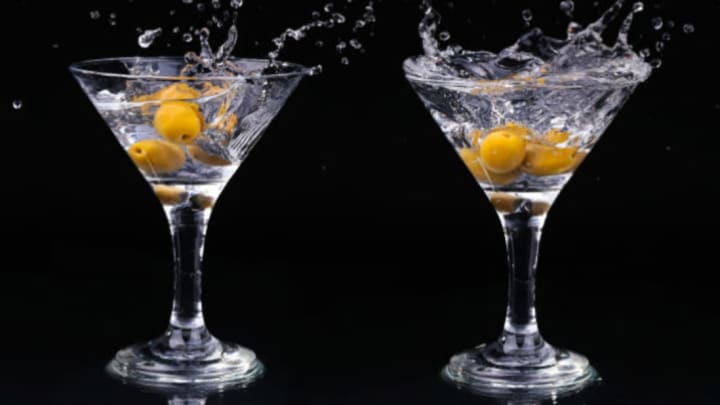In the last few decades, it’s become almost customary to call anything served in a martini glass a martini. But the only thing that these cocktails have in common with the classic Martini is the glassware.
Like most parts of drinking history, the Martini is the center of much debate. Whole books have been devoted to its history, and their authors have come to wildly varying conclusions about the cocktail’s name and origin.
Drunk History
The most colorful story is that the tipple was created in the 1870s for a gold miner who struck his fortune in Martinez, California. He wanted to celebrate with champagne, but the bar didn’t have any. Instead, the bartender mixed together sweet vermouth (a type of fortified aromatic wine), gin (probably a light, sweet version called Old Tom that was popular during the era), and a lemon twist.
The bartender named the cocktail after the town, and the miner liked it so much he had more than a few. At this point, the guy was so inebriated that he started slurring off the “z” in Martinez, and the cocktail’s current name was born. (Side note: the Martinez is still available in some bars. Be prepared, it’s quite different than the Martini.)
Alternative Storylines
Another origin story is that the Martini was the name for any cocktail made with Martini & Rossi Vermouth, which hit the American market in 1863. At the time, most cocktails didn’t have fancy names, but followed a pretty general pattern (spirit, bitters, water, sugar) and were ordered by the name of the booze they contained. Some examples: Whiskey Cocktail, Gin Cocktail, Fancy Gin Cocktail, etc.
Yet another (likely anachronistic) story is that the Martini was invented by a New York bartender in 1911 at the Knickerbocker. Mythology aside, the original was probably a 1:1 or 2:1 ratio of gin to vermouth. It might have been made with sweet or dry vermouth and also included a splash of sugar syrup and possibly some orange bitters. It was likely garnished with a lemon twist. But all of those particulars have been lost to time.
What we do know is that the dry Martini probably entered history around 1900 with a 2:1 gin to vermouth ratio. By 1930, the ratio was closer to 5:1. At the height of the Three Martini Lunch, the prevailing recipe was eight parts gin to a hint of vermouth, garnished with an olive.
Spirited Changes
When vodka first outsold gin to become the best-selling white liquor in the United States in 1967, many bartenders and consumers replaced the gin in their cocktails with vodka. This trend only intensified with James Bond’s famous “shaken, not stirred” Vesper Martini. So even though the original was made with gin, don’t be surprised if your bartender asks about your preference of spirit, mixing method, and garnish. After all, the cocktail has changed a bit since it was first created.
Hit The Lab
Modern Martini
2 oz gin (higher proof, if possible)
1/2 oz dry vermouth
Olive for garnish
Combine gin and vermouth in a mixing glass. Add ice and stir vigorously for about 10 seconds or until it starts to chill. Strain into a cocktail glass and garnish with an olive.
Martinez
2 oz gin (Old Tom style)
1 oz sweet vermouth
1 dash maraschino liqueur (optional)
2 dashes orange bitters
Lemon peel, for garnish
Combine all ingredients except garnish in a mixing glass. Add ice, and stir for about 15 seconds or until mostly chilled. Strain into a cocktail glass and garnish with lemon peel.
